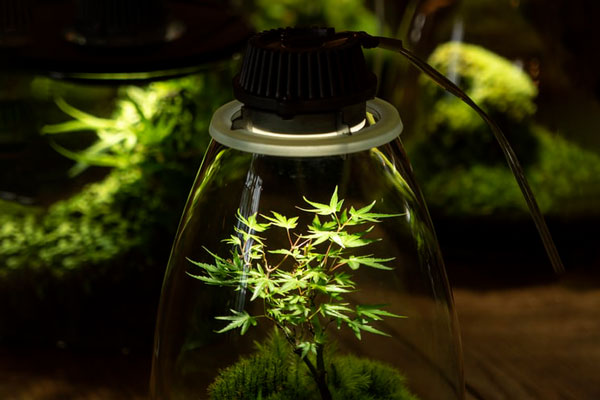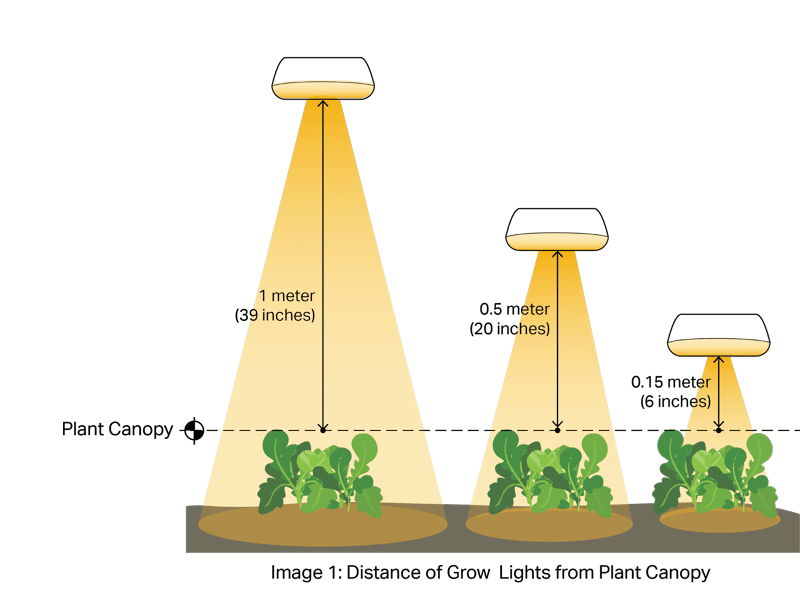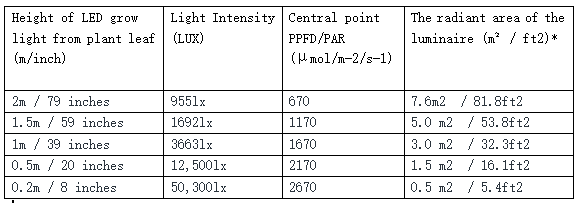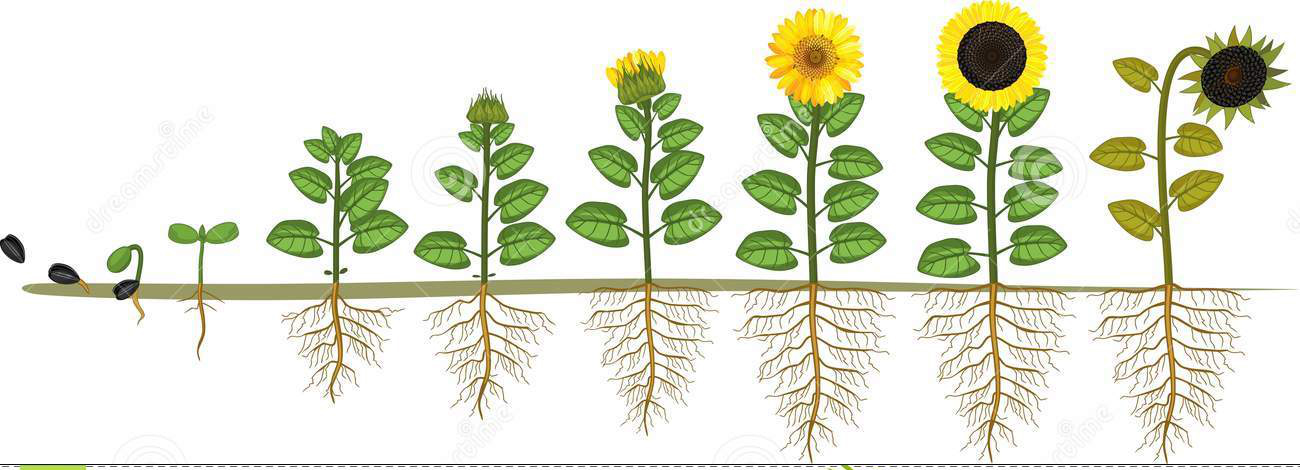How Far Should The LED Grow Light Be From The Plant? -- Height Analysis Of LED Grow Lights Grown Indoors For Hemp And Other Plants
Writer:Jane Time:2020-10-07 Browse:186

Today, more and more growers are installing LED lighting instead of traditional HID and T5 fluorescent lights. LEDs emit less heat than HID light sources, which means that the proximity of LED planting lights to the tree canopy is different from that of conventional planting lights. It is also important to understand how the optimal growth distance affects the different stages of plant growth.
This article Outlines the different lighting needs of various plants, including cannabis, according to their growth stages. It also discusses how to determine the appropriate distance for LED lighting from the plant canopy to the growth of nourishing plants, and the importance of PPFD(PAR) and other popular terms for growth lights.
How do you measure the light used for plant growth
Let's quickly define PAR and PPFD. PAR(Photosynthetically Active Radiation) describes the part of the visible spectrum that plants "see" and use for photosynthesis (400nm-700nm). PPFD(Photon Flux Density for Photosynthesis) measures the amount of light (PAR) a plant receives over time. PPFD represents the density of light received by the plant over time, expressed in micromoles [photons] per square meter per second.
One way to visualize PPFD is to imagine the sun "pouring" light onto a plant's leaves. When the sun shines sunlight on the plants, their leaves are collecting energy. PPFD is a measure of the amount of light (photons) that the sun "pours" onto plants over time. PPFD is an important indicator because it helps growers accurately measure the light intensity of photosynthesis at the canopy level. This is also important because lights placed too close to the tree canopy can cause burning, fading, stunted growth or discoloration.
Distance diagram of LED grow light


Table 1: Distance between LED plant light and plant canopy (600W LED plant growth light)
* Coverage will vary depending on the growth lamp used. The LED plant lamp shown here does not use a lens to direct the light distribution.
Table 1 shows the performance of a 600W LED grow light at different distances from the plant canopy. It Outlines the light intensity (lux), provides PPFD(μmol/ m-2 / s-1 or micromoles per square meter per second), and also shows the "light footprint" or canopy coverage. Intensity, PPFD/PAR, and "light footprint" all varied with increasing or decreasing the distance between light and the plant canopy.
Table 1 also highlights how changing the distance of the same 600-watt LED light alters the light intensity and 'light footprint' or canopy coverage of the plant. The intensity of light increases as the source is located closer to the tree canopy. In general, the growth lamp should be placed close to the canopy for the vegetative phase of plant growth and higher (away from the canopy) during the flowering period.
Where should the growth lamp be placed?
For seedlings, LED grow lights should normally be placed between 24 and 36 inches above the plant canopy -- however, this depends on the power (wattage) of the light source. Place the LED planting lights furthest from the plants (~ 36 inches) -- this will keep the heat and light levels low and help prevent the plants from drying out. Once the root system is established and begins to bud, it can move the lamp closer (usually within the first 2-3 weeks).
During the growth phase, LED planting lights should be 12 to 24 inches from the top of the tree canopy. At this stage, more light is needed for photosynthesis, so the source should be near the plant.
As plants enter the flowering stage, the need for bright light diminishes. The parietal lobe of the canopy should be 18 to 24 inches from the light source to produce flowers. It is at this stage that the plant grows in height and produces fruit. Depending on the light and how you want your crops to grow, you won't have to change the height of the light during flowering, especially if you don't want tall plants.
How far should the LED grow light be from the seedling?
In the early stages of growth, seedlings are fragile and require less light. This means that you don't want to increase the strength too early, because the seedlings will reproduce in a gentler way. Depending on the size of the light, the growing light can be safely held somewhere between 24 and 36 inches from the top of the soil.
How far should the LED grow light be from the plant clone tissue
Cannabis cloning is a process in which cuttings or cuttings from mature plants are used to grow another plant of the same kind. The distance of the LED grow lightt above the clone is different from the height required for the seedling. For clones, they will need intense light to begin with. Depending on the light intensity and maturity of the plant, the difference between 14 and 36 inches from the top of the plant canopy can be significant.
How far should LED grow lights be used
As plants grow, their needs change. After the vegetative stage is complete, the plant enters the flowering or "flowering" stage. For mature factories, they have become necessary places to thrive. During the flowering stage, LED grow lights should be located between 16 and 36 inches from the plant canopy. Moving the growing light closer increases the light intensity, thus maximizing photosynthesis. However, if the growth lights are too close to the top of the plant, they may cause the growth area to expand, spread and even damage the plant.
What about the other stages of growth?
Plants need different levels of light depending on each stage of growth. In order to know exactly how far light a plant should be growing, it is important to consider the different stages of growth. It is also important to consider the power output of the growing lamp - this is usually related to the power of the light source, which is the main factor in determining the optimal distance of the LED at the beginning of the growing process.
Plant growth can be roughly divided into three stages - seedling, vegetative and flowering.

This means that once healthy roots are firmly established, it is time to increase the intensity and decrease the light.
Seedling stage
During the initial phase as a seedling, the LED grow lights should be placed over the plant to prevent the soil from drying out.
Some growers may try to dynamite seedlings with high intensity light to promote faster growth, but this will not help until the plant is established. At this early stage, the seedlings are too fragile and a gentler approach is needed. Once the plant matures, higher light intensity is needed to promote photosynthesis.
Vegetative
Plants respond well to bright light during the vegetative phase - it is during this period that they mature and use photosynthesis to grow rapidly. To increase light intensity, LED grow lights should be located closer to the plant canopy. Strong, healthy stems and roots are the key to success in achieving a repeatable yield.
Increasing light intensity can facilitate growth during the vegetative period, but it is important to monitor the plant closely to ensure that adverse symptoms caused by too much or too little light are on the lookout.
Flowering period
Flowering is the final stage of a plant's growth cycle -- the period during which fruit production and stem growth accelerate. As plants grow from vegetative to flowering or anthesis, the good practice is to "stage" the transition. To do this, gradually raise the height of the LED grow lights away from the canopy of the plants (using the height advice outlined earlier). Monitor distances closely and keep in mind the crop height and flowering requirements required for a particular plant/crop.
The adverse effects of too much light
When plants like cannabis receive too much light at any stage, they often show symptoms of distress. Since LEDs don't give off much heat, the main thing to monitor closely is any signs of "burnout." Other side effects associated with growing lights too close to the plant canopy may be discoloration or stunted growth/irregular growth. Both must be quickly identified and the height of the growth lamp adjusted accordingly.
Hemp plants show signs of light burning, including upturned leaves and what's called "bleaching." Bleaching is the white or yellow discoloration of the leaves closest to the light. Mild burns can also be recognized when the veins of a plant turn green and the rest of the leaves turn yellow.
Increase the distance of light - hemp and other plants
The use of LED grow lightts for cannabis production is becoming more common as growers move crop production indoors. LEDs also bring benefits to growers because they can use a particular spectrum to provide more targeted lighting conditions for different crops. When considering the use of LED grow lights compared to traditional light sources, other benefits include lower power consumption, lower positive heat and increased production in a shorter period of time.
The increased distance of light should reflect the height and uniformity of the plant desired by the grower, with scattered leaves and healthy flowers. If we look at the crop demand for salad vegetables or lettuce compared to hemp, we find that salad vegetables and lettuce are good for short-term, broader growth, while hemp is better for taller, narrower growth.
No matter what crop you use, farmers and cannabis growers want the highest quality yield per unit area in a short growing cycle.
Illumination distance of traditional grow light
Traditional high intensity discharge lamps (HID)(e.g., high pressure sodium (HPS) and metal halides) and fluorescent lamps were widely used before LEDs were gradually adopted for indoor growth applications. For the first time in history, these lights cost much less than LED planting lights and are therefore cheaper to buy and therefore available to large indoor growers.
HID or fluorescent lamps should be more distant from the plant canopy than from the LED. This is partly because they emit more positive heat than LEDs, but they also provide only a few different wattage/light outputs. The mounting distance of the growth lamp varies for each stage of the growth and depends on the wattage of the grow light used.
Although traditional grow light for the first time to use lower cost (purchase price), but over time they need more maintenance - the light bulb requires more frequent replacement and/or clean - and they are obvious limitations in terms of lighting control - not many lights dimmed and the possible need for a long time to open the full light output.
Fluorescent lamp
There are three (3) basic types of fluorescent growth lamps -T5, T12 and compact fluorescent lamps. To obtain different light intensities, the grower must adjust the height of the plant canopy lights accordingly. One of the advantages of fluorescent lamps is that it is difficult to ignite light because they do not give off enough heat. In any case, light intensity and heat should always be closely monitored.
For green shoots, about 6-12 inches is a reasonable height to start with, as they require higher light intensity. As they mature from nourishment to flowering, it makes sense to double this distance to 12-16 inches. In general, when using T5, it is best to keep them as close together as possible, but watch for overheating or drying.
HID grow light (Metal Halide and High Pressure Sodium -- HPS)
Metal halide (MH) lamps provide a large amount of blue light -- a spectrum considered most suitable for vegetative growth stages (3). High pressure sodium (HPS) lamps are ideal for plant growth and flowering. Both produce more heat than LEDs, but are relatively cheap to buy.
One way to measure HID heat is with the back of your hand. This will help you determine the correct distance to grow the light. Simply place your hand on the top of the canopy and hold it for 30 seconds. Your hands should be hot, but not bearable. If this happens, increase the distance of the growing light above the plant.
Many commercial growers use 1000W HID lighting, which usually starts with 19-26 inches of height. From here, they can get closer together.
However, because HID produces a lot of heat, it is important to avoid burning that heat, which can damage any plant. Additional, because HID lamp sends out the heat quantity is taller, because this indoor ventilated is very important.
With more than 10 years of collective experience and expertise, PanTech is a leader in LED grow light solutions and continues to innovate and drive the industry forward. Pan-Science Technology Biology leads the industry in our research-based approach to LED grow lights, as we build outstanding full-spectrum LEDs that enable plants to become stronger and more productive from seed to maturity.
Consuming 50% less power and generating 50% less heat than HPS, our GLMX plant lights provide up to five years of natural light for your plants. The GLTW series of LEDs offer an optimized spectrum for excellent plug and play results. We continue to support our partner's LED integration, so our growth lights are easy to install and effortless to maintain.


